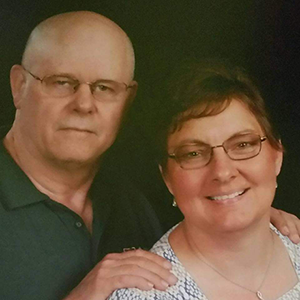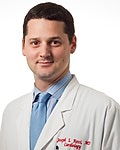Roger Darr’s heart attack was caused ventricular fibrillation, or “sudden cardiac death”. Most patients who experience ventricular fibrillation at home do not survive. But thanks to high quality CPR provided by his quick-thinking wife, first responders, the Emergency Room staff at Central Carolina Hospital, and the providers at the UNC Medical Center, Roger is around to tell his story.

Roger Darr’s heart stopped just after his lunch break. If his wife hadn’t been with him, it likely wouldn’t have started again.
After spending his morning at the top of a 10-foot ladder, preparing to run wire at a building in Sanford, his wife Diana showed up with lunch. Roger works in IT and was installing hardware in a building still under construction. He took a break to sit with her and eat the salad she brought. After they finished, she offered to help him carry a few spools of wire to the second floor.
He had nearly carried all the boxes up when Diana saw him sit down on the steps leading to the roofline. For a moment it appeared as though he had just taken a moment to rest. Then he slumped and she knew something was wrong.
He was unresponsive. He wasn’t breathing. He didn’t have a pulse. Diana pounded on a nearby window to get the attention of a group of construction workers outside. They called 911 while she began CPR.
She had taken a CPR class a few years before, something her employer requires everyone on staff to do. She admits that her certification was a little out-of-date.
“It’s been a little while since I’d been through the program,” she said. “I think they were still teaching rescue breaths the last time I got certified.”
Diana performed CPR on Roger for more than 10 minutes before the EMTs arrived and relieved her. When they did, she collapsed. She was exhausted.
Joe Rossi, MD, director of Cardiac Catheterization Lab at UNC Hospitals, who placed Roger’s stent after he arrived to UNC, said that her quick response is part of the reason Roger was able to come through his experience so quickly and so well.
“During a cardiac arrest, consistent, high-quality CPR can dramatically reduce the more catastrophic outcomes such as brain damage,” said Rossi, who is also a Clinical Associate Professor in the School of Medicine and Program Director of Interventional Cardiology Fellowship.

The EMTs managed to revive Roger with a combination of CPR and defibrillation, loaded him into the ambulance, and took him to the emergency department at Central Carolina Hospital.
“Roger’s mother met us at the ED,” recalls Diana, “so did our preacher, and we all prayed together right there in his room. Right after that I looked at his monitors and I knew something was not right.”
Roger coded again shortly afterward.
The doctors at Central Carolina stabilized him quickly but recognized that the care Roger needed would require emergency transfer. The ED doctors at the Sanford hospital contacted the UNC Medical Center Catheterization Lab and the Carolina Air Care Helicopter to pick Roger up.
He was still unconscious when he arrived at the cath lab, but he had an occlusion in his left main coronary artery, a blockage commonly described as “the widowmaker.”
“That’s the artery that supplies most of the blood to the heart, and when that artery occludes most people don’t make it, most people die suddenly. And that’s what happened to Mr. Darr. His heart stopped twice before he arrived at UNC and then for a third time when he laid down on our procedure table.”
When Roger coded for a third time it was while he was on the table in the cath lab. To take some of the pressure off of his heart, Dr. Rossi inserted a device called an Impella through an artery in Roger’s groin.
“The Impella is a minimally invasive left ventricular assist device. It has a little motor that sucks the blood out of the heart (the left ventricle) and keeps it circulating in the body. It’s doesn’t pump as efficiently as a heart, but it does enough that if your heart is just very weak, or stops, it can make up the difference and provide time for us to place a stent.”
As the Impella was placed, CPR continued, which is not standard protocol but was necessary given the severity of Roger’s condition.
“It’s very unusual to place an Impella while someone is receiving CPR but it can be done. And that’s what we were forced to do for Mr. Darr. We did the whole procedure while we continued CPR to keep him alive. The truth is that most patients don’t make it through something like that.”
These interventions were necessary to keep Roger’s blood circulating to his organs and give Dr. Rossi and his team time to place the stent and open the blockage. Rossi said that the CPR Roger received throughout his experience was crucial to his survival and quick recovery.
“Not only did he receive really good CPR from our cath lab staff while we were placing the stent, he also received high-quality resuscitation in the Central Carolina- Sanford ER, and from his wife and from EMS before he arrived at the hospital,” Rossi said. “He’s been able to recover so well and so quickly because he received such effective CPR through the whole experience.”
Even after his stent was placed – and though he had come through a procedure that most people don’t survive – his condition was still precarious.
“They tell me I kept two nurses running for 48 hours straight,” Roger said.
For those two days Roger’s body temperature was kept low to prevent organ damage. This is also known as “targeted temperature management”, which minimized organ injury after cardiac arrest.
Roger was particularly susceptible to such an injury, since he had lost one of his kidneys years earlier to cancer. If the remaining one was damaged, it meant a lifetime of dialysis.
Roger spent a week in a medically induced coma, with a respirator to help him breath. When his doctors thought his body could handle it, he was taken off the respirator and brought back to consciousness.
When he woke up, Diana remembers, he was still very weak.
“Those first few days he couldn’t even hold a glass of water to drink it.”
But he bounced back quickly and after a short period of rehabilitation, he was becoming his old self.
“His last week in rehab, it was almost like he was back at work, giving people advice about their computers,” said Diana.
Now back at home in Sanford, Roger has to take it a little easier than he used to – for now he’s not climbing up ladders to run wire, but he’s helping customers set up their computers. He was sent home from the hospital with a walker and wheelchair to help him get around. According to Diana, he never once used the wheelchair and only needed the walker for a couple of weeks.
Dr. Rossi said that the quality and speed of Roger’s recovery has everything to do with the quality of care he received throughout the experience – from his wife giving him CPR, through the excellent care he received in Sanford, to the work of his cardiac care team at UNC Medical Center.
“He was lucky,” said Rossi. “His wife was trained in CPR, the EMTs were contacted quickly, he got great care in Sanford and he was transferred here efficiently. If we can get patients to UNC quickly from other hospitals, more of them are able to survive major events like this. The fact that Roger was able to bounce back so quickly is a testament to the quality of care he received at every step in the process.”
Since going back to work, Roger has made sure his customers know how important it is they are prepared for someone having a heart attack, because he knows firsthand that the key to survival is a quick response.
“It’s imperative,” he said. “If you can help keep someone alive in those first few minutes, it can make a huge difference for them and their family.”